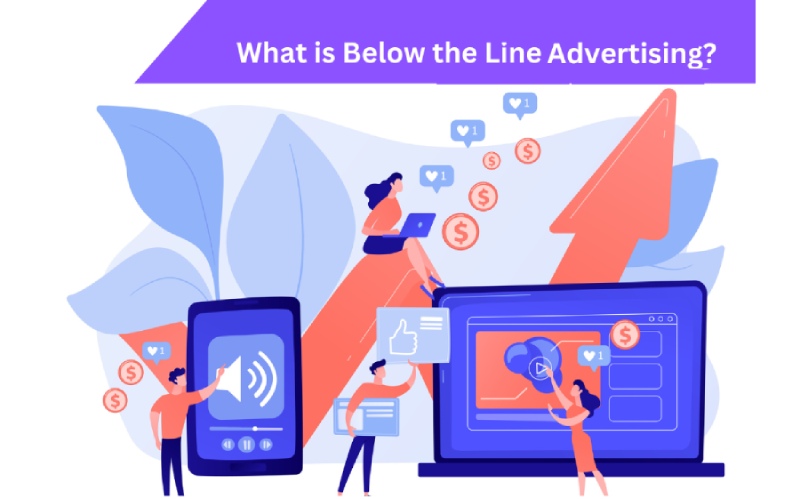Business
Understanding Below-the-Line Advertising: Key Strategies and Marketing Applications

What is Below-the-Line Advertising?
Below-the-line advertising promotes projects in mediums other than the traditional radio, television, billboards, print, and film. Direct mail campaigns, social media marketing, trade exhibitions, catalogs, and targeted search engine marketing are some of the advertising systems available. Compared to above-the-line strategies, below-the-line advertising methods typically have a lower cost and are more targeted, reaching customers directly.
Understanding Below-the-Line Advertising
Instead of casting a broad net across huge audiences, below-the-line advertising seeks to reach out to people directly. Rather than broadcasting a national commercial during a popular network television show, a below-the-line campaign could focus on an in-store demonstration of a product that customers might want to see in person. This provides a more hands-on experience in which a salesman may answer direct questions and better explain a product. Some examples of below-the-line advertising are:
Targeted Online Marketing
With their advertising campaigns, businesses can target specific demographics like a consumer’s age or industry. For example, marketers can use LinkedIn’s sidebar advertisements to target specific individuals based on their profession or membership in specific groups.
Direct Mailing
Direct mail advertising is still used by companies, especially for older customers who still don’t use the internet as much as younger customers (as of 2022, the age gap between those who use the internet and those who don’t was 24%, down from 56% in 2000). Postcard mailings and catalogs remain popular and efficient marketing tools.
Trade Shows and Presentations
Businesses frequently promote their products and services through the local chamber of commerce. Banks host mortgage seminars to answer questions regarding mortgages, interest rates, and house affordability in the hopes of attracting new loan customers.
Of course, no marketing tool is flawless and works every time. Instead, companies frequently subscribe to various techniques. For example, a company may send out a direct mailing of printed flyers to promote an upcoming event at the local convention center.
Above-the-Line vs. Below-the-Line Advertising
Above-the-line advertising is intended to reach large audiences. Its pinnacle is the Super Bowl television ad, which costs millions of dollars for a few seconds of airtime while instantly reaching tens of millions of customers worldwide. On the other hand, a significant percentage of those viewers might not represent a company’s target consumer.
On the other hand, below-the-line advertising reaches fewer people but selects its audience more carefully. In most situations, below-the-line advertisers perform significant market research to define a target niche of buyers who are likely to purchase a product. Once the target audience has been defined, below-the-line advertising can contact consumers in a more personalized and direct manner.
Above-the-line ads cast a wider net than below-the-line commercials, which utilize a figurative fishing pole through direct mailings, face-to-face contacts at trade shows, or paid search engine results that appear when customers type specific searches.
Benefits of Below-the-Line Advertising
Lower costs are seemingly the greatest benefit of below-the-line advertising. While TV and radio ads might be costly, direct mail and search engine marketing are significantly less expensive. Furthermore, below-the-line solutions can be more cost-effective and readily scaled up or down.
It is also simpler to track conversions with intended customers when below-the-line methods are used. Even though there are several methods for analyzing the efficiency of TV and radio ads, determining their total impact remains difficult. Since individuals every so often review their experiences wrongly, getting some information about an organization can yield problematic outcomes. Email and search engine marketing, then again, definitively track the connections that clients click, providing firms with important data.
Customer engagement is essential in today’s business environment, which is fueled by below-the-line marketing. While above-the-line approaches are successful in raising general brand awareness, below-the-line measures are best for building further bonds with potential customers.
What is Below-the-Line Advertising?
Below-the-line advertising seeks to reach clients through out-of-the-mainstream formats such as direct mail campaigns, social media marketing, trade shows, catalogs, and targeted search engine marketing. It’s a better approach to connect with potential customers.
What Is the Definition of Above-the-Line Advertising?
Above-the-line advertising makes use of popular formats such as radio, television, billboards, print, and film. It promotes brand exposure by casting a wide net rather than focusing on individual potential consumers.
Should Below-the-Line Advertising Be Combined with Above-the-Line Advertising?
In general, Yes. Each type of advertising works in its own way, so they complement rather than compete with one another.
Which Is Cheaper, Below-the-Line or Above-the-Line Advertising?
One of the most attractive aspects of below-the-line advertising is the low cost. TV, newspaper, and radio ads are typically costly, whereas direct mail, a LinkedIn ad, or attendance at a trade show are significantly less expensive.
The Bottom Line
Below-the-line advertising aims to reach customers directly and specifically. It is less expensive than above-the-line advertising, which targets a much larger audience and is better suited to establishing brand awareness. Using both tactics to market a product is usually the best option because they complement one another.
-

 Business4 weeks ago
Business4 weeks agoHow to fill MSME Form 1? Step-by-Step Guide
-
Business4 weeks ago
From Marine to Chief: The Leadership Journey of Sean Mannix
-

 Gadget4 weeks ago
Gadget4 weeks agoAfter Grand Success on BLDC Ceiling Fan, Eff4 Is Launching Smart Bulb
-

 Festivals & Events4 weeks ago
Festivals & Events4 weeks agoGoogle Celebrates Cherry Blossom Season with Animated Doodle
-

 Business2 weeks ago
Business2 weeks agoPrakash and Kamal Hinduja: Driving Social and Environmental Change
-
Education3 weeks ago
Fred DuVal: University Leadership as a Critical Resource for Climate Change Research and Life-Saving Solutions
-

 Sports4 weeks ago
Sports4 weeks ago2025 NASCAR Craftsman Truck Series Baptist Health 200 at Homestead-Miami Speedway: Race Preview, Prediction, Schedule, Entry List, Drivers to Watch and How to Watch
-

 Health2 weeks ago
Health2 weeks agoThe Hinduja Brothers Commitment to Global Health: Empowering Communities Across Borders

























